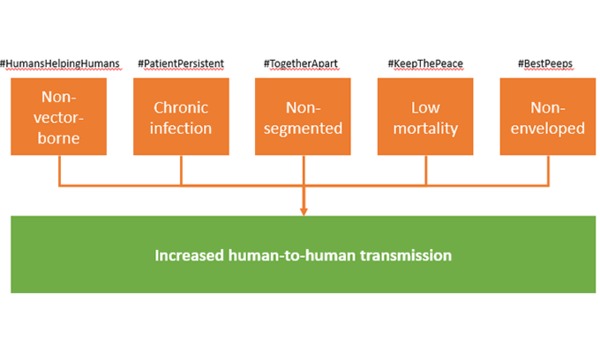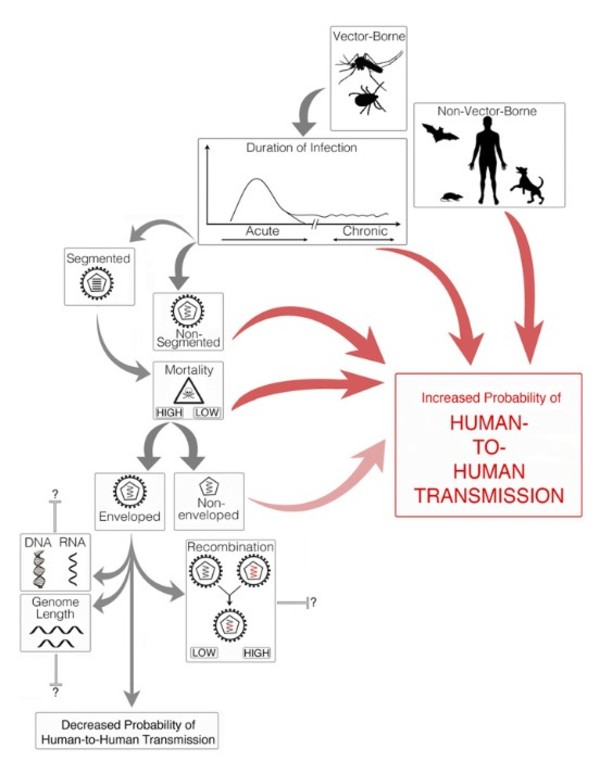
When an idea catches on, what do we call it? “Going viral.”
In the age of Coronavirus, we need good messages to go viral. Whether you’re running a business, an organization, or a family, you need good messages to go viral. As a society, we must encourage people to #SlowTheSpread and help our #HealthcareHeroes: we need good messages to go viral.
But how do we help good messages to go viral, faster than the virus itself?
We spent some time digging into virology research papers, and we have some good news: we learned principles from viruses that can be applied to communication.
We learned how viruses think. And we will use that to defeat them.
The first paper is called Virological factors that increase the transmissibility of emerging human viruses, published by the prestigious National Center for Biotechnology Information. Because you’re too busy to wade through it, we’ll skip to the money shot:

In a nutshell: viruses that can be transmitted from human to human (like COVID-19) are vastly more contagious than viruses that can only be transmitted by mosquitos, bats, dogs, etc. (like, say, rabies). The authors isolated five factors that help viruses make the “leap” to human-to-human transmission:
- Non-vector-borne: A “vector” is a carrier like a mosquito or bat. In plain English, “non-vector-borne” means you could pick up the virus if, say, someone sneezes on your dinner plate: no carrier needed.
- Chronic infection: In simple language, “acute” means you get it and die. (Lower transmission, because you’re dead.) “Chronic” means you get it and suffer for a longer time. (Higher transmission, because you’re sneezing all over dinner plates for weeks.)
- Non-segmented: A “segmented” DNA or RNA strand means it’s all one piece. “Non-segmented” means it is made of different pieces that replace each other and more easily mutate. It’s like packets of an email that are split up and sent over the Internet, as opposed to a single mailed letter. It’s harder to stop packets.
- Low mortality: When humans die, the virus doesn’t get a chance to spread. If they stay alive, it does. You want to keep humans alive and sneezing, preferably on dinner plates.
- Non-enveloped: If a virus has an outer membrane, it’s called “enveloped.” It appears that non-enveloped viruses (let’s call them “naked”) are more successful at staying alive on surfaces like dinner plates, making them more contagious.
How to Make Stuff Go VIral: Learn from Viruses
Our philosophy is that everything in nature correlates with everything else. Information is like a virus, which is why we call a good marketing idea a “viral campaign.” (Here’s the paper on that one, if you’re interested.)
If everything correlates with everything else, then we should be able to use the principles of viral contagion to create viral information. If COVID-19 is the virus, let’s make good communication the antivirus.
We will use the virus’s tactics against it.
Because we are humans, we will not spread these ideas to human bodies; we will spread them to human minds. We will rip a page right out of the COVID-19 playbook.
We will create ideas that are:
- Non-vector-borne: We will get humans to help us spread these messages. We will not try to spread them through Facebook Ads or Google AdWords. We will have humans tweet, TikTok, and text each other. We will get #HumansHelpingHumans.
- Chronic infection: We will not try to overwhelm people with one big Super Bowl ad. We will spread messages in as many channels as possible, over as much time as possible. We will be #PatientPersistent.
- Non-segmented: We will not try to create glossy messages that are overpackaged and overproduced. We will give people a framework for messages, then let them spread it in a decentralized way. We will be #TogetherApart.
- Low mortality: We will not kill anyone with our messages. In other words, we will try to live by the Hippocratic Oath: “first, do no harm.” We will do our best to spread helpful and truthful information, to #KeepThePeace.
- Non-enveloped: We will make lightweight messages that will last longer on household surfaces. In other words, we will align with principles — human virtues — that stand the test of time. We will be #BestPeeps.
That’s the playbook. If you’re communicating during this time, try to align with these viral principles if you want to create a viral message. If you think like a supervirus, your message is more likely to survive … and thrive.
One last piece of good news: in this final research paper, the authors prove that when good information is introduced into an ecosystem that contains bad information, the good idea wins out. Good information literally filters out the bad. In these tough times, that is incredibly encouraging.
5 Coronacrisis Communication Best Practices:
> Think like a virus: get some messages out there. See what sticks. Iterate and improve.
> Don’t overproduce: simpler, shorter, lighter messages work best.
> Push power to the people: empower your team to share the message in their own words, on their own terms.
> Get the message out in as many channels as you can, as often as you can.
> Spend 10% of your time helping others.